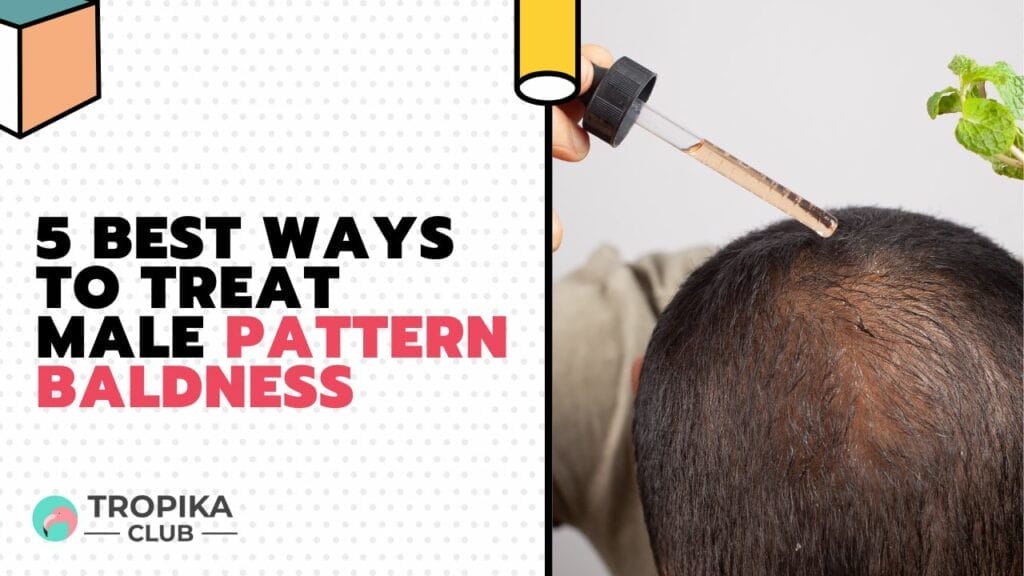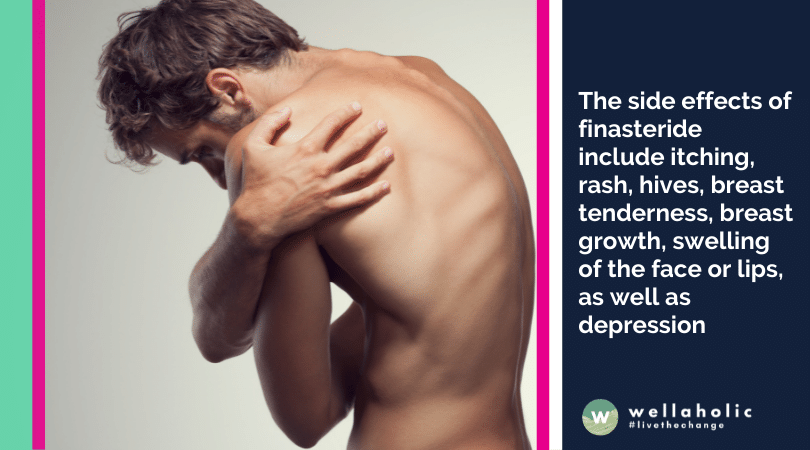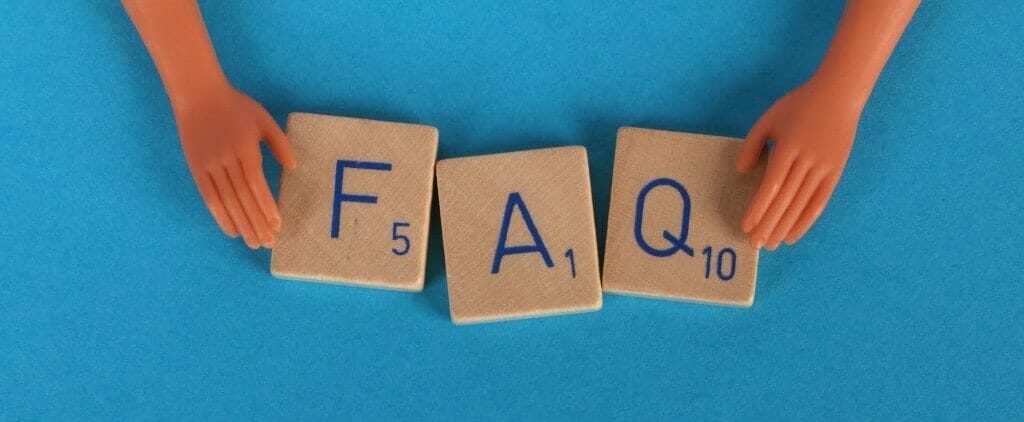5 Best Ways to Treat Male Pattern Baldness
There are 16% of men between 18 and 29 year old can experience male pattern baldness. The prevalence of the condition increases with age: the U.S. National Library of Medicine (NLM), has discovered that over 50 percent of all men over 50 year old will experience some extent of by male pattern baldness. Tropika Club enlisted the help of the experts at Wellaholic to help you keep your crowning glory, and the Best Ways to Treat Male Pattern Baldness.

Table of Contents
No Time to Read? Here’s a Snappy Summary of This Article
- Follicular Magic: Harness the power of hair transplant surgery for a natural and lasting solution to male pattern baldness.
- Minoxidil Marvel: Witness the mane revival with over-the-counter minoxidil, a topical treatment that stimulates hair growth and thickness.
- Finasteride Fix: Take a pill, defy baldness! Discover how finasteride blocks hair loss hormones, promoting hair regrowth and thickness.
- Laser Locks: Shine a light on baldness! Explore the laser therapy that stimulates hair follicles, promoting fuller and thicker locks.
- Platelet Power: Embrace the future with platelet-rich plasma therapy, using your own blood to stimulate hair growth and combat balding.

What is Male Pattern Baldness?
But before we get on the hairy side of things, let’s take a quick look at this type of hair loss. After doing endless research on Google, maybe you’ve even heard of the term before: androgenetic alopecia. Some hair care experts use it to refer to pattern baldness in males (and females), and there are all kinds of genetic and environmental factors that can causing the condition. With this condition, the hair’s growth cycle is weakened, and hair follicles shrink. Then you get shorter, thinner strands of hair. In time, the natural growth cycle of your hair ends, but there are new hair growth to replace and renew the cycle.
Male Pattern Baldness, or androgenetic alopecia, is a common form of hair loss in men, influenced by genetic and hormonal factors. It typically follows a specific pattern, with hair loss starting at the temples and crown, creating a recognizable shape. The primary culprit is dihydrotestosterone (DHT), a hormone derived from testosterone, which affects hair follicles’ size and lifespan. Over time, follicles become miniaturized and produce thinner, shorter strands, eventually leading to a halt in hair growth. The condition is hereditary, and its onset varies, often beginning in adulthood. While Male Pattern Baldness is a natural part of aging, treatments like medications (e.g., minoxidil, finasteride) or hair restoration procedures offer options for those seeking to address or slow down hair loss.
This form of hair loss can observe a well-defined pattern that starts from above the temples on your head. As the hairline recedes, it forms the characteristic ‘M’ shape, and the hair thins at the top of the head—the crown. Most of the time, androgenetic alopecia can lead to partial or complete baldness.
What causes Androgenetic Alopecia?
Androgenetic Alopecia, commonly known as Male Pattern Baldness, is primarily caused by a combination of genetic and hormonal factors. Individuals with a family history of baldness are more likely to experience it. The key player is dihydrotestosterone (DHT), a derivative of testosterone. In genetically predisposed individuals, hair follicles in certain areas, such as the temples and crown, are sensitive to DHT. This hormone miniaturizes the follicles over time, causing them to produce finer and shorter hair until they eventually cease growing altogether. Hormonal changes, aging, and an individual’s overall health can also influence the onset and progression of Androgenetic Alopecia. While it is more common in men, women can also be affected, experiencing a diffuse thinning of hair. Various treatments, including medications and hair restoration procedures, aim to address or slow down the effects of Androgenetic Alopecia.
Most of the time, androgenetic alopecia genetically predetermined disorder due to an excessive response to androgens. Androgens constitutes a group of hormones that mainly influence the growth and development of the male reproductive system. One example you may be familiar is testosterone. That’s why androgenetic hair loss can occur in early adolescence, because the regression of scalp hair, or baldness, can be influenced by androgens.
But there are medical conditions and medical treatments that can be serious causes for this condition: cancers, thyroid conditions, anabolic steroids, as well as some medications. Certain health conditions could cause baldness. When you have unexpected rashes, redness, pain, peeling of the scalp, hair breakage, patchy hair loss, or even an unusual pattern of hair loss accompanies the hair loss, you should go see a doctor, ASAP. Because you might need proper blood tests or a skin biopsy to diagnose the disorders behind the hair loss.
Treating Androgenetic Alopecia

1. Finasteride (Propecia, Proscar)
This is an oral medication that can slow down the male pattern of hair loss by blocking the male hormone that’s responsible for hair loss. This can only be use in men. Finasteride has been shown to be more effective than minoxidil, another common medication to treat hair loss (we’ll cover that in the next point!)
If you’re taking finasteride, you need to continuously do so. Its ability to slow down the this type of hair loss will only show when you take the medication. Most of the time, it takes three months to a year before you can see results. If not, you should speak to your doctor before you stop taking the medication.
The side effects of finasteride include itching, rash, hives, breast tenderness, breast growth, swelling of the face or lips, as well as depression. In rare cases, the effects of finasteride can cause breast cancer too. One of the other side effects of finasteride actually affects the prostate-specific antigen (PSA) tests used to screen for prostate cancer, leading to increased risk of undetected prostate cancer.
2. Minoxidil
Minoxidil, or Rogaine, is a very common type of hair regrowth treatment, one of the more effective treatments too. (Psst, we use it for our Microneedling for Scalp treatments) This is a topical medication that you can apply on your scalp, and it slows hair loss while stimulates the hair follicles to grow new hair. It usually takes four months to a year to see visible results. Like finasteride, you hair loss returns when you stop applying minoxidil.
The possible side effects are irritation, dryness, a burning sensation, as well as the scaling of the scalp. There are more serious side effects as well, and you have to see the doctor if you experience weight gain, swelling of your face, hands, ankles, or abdomen, rapid heartbeats, chest pain, trouble breathing when your lie down, and laboured breathing.

3. Hair Transplants
Hair transplants are a surgical solution for hair loss, particularly in cases of Androgenetic Alopecia. The procedure involves transplanting hair follicles from a donor area, usually the back or sides of the head, to the balding or thinning areas. There are two primary techniques: Follicular Unit Transplantation (FUT), where a strip of scalp is removed and dissected into grafts, and Follicular Unit Extraction (FUE), where individual follicles are extracted one by one. These transplanted follicles then establish themselves and continue to grow hair in their new location. Hair transplants provide a long-lasting and natural-looking solution, but it’s essential to consider factors like candidacy, expectations, and potential side effects before undergoing the procedure.
This is the stuff of A-list celebs. But a hair transplant isn’t a breeze; it’s actually one of the most invasive and expensive hair loss treatment you can find. For hair transplantation, the hair from other areas of the scalp that still have active hair growth will be removed, so that it can be transplanted onto the thinning or balding areas on your scalp. Though you can look forward to natural-looking healthy hair that’s permanent.
While this may be a permanent solution, you’d need multiple hair transplants. Not to mention, you’ll risk scarring and infection on your scalp. Well, you know what they say about beauty and pain.
4. Low-Level Laser Therapy (LLLT)
Don’t be put off by this sci-fi sounding therapy. LLLT is a modern non-surgical hair loss treatment. It’s touted as one of the safer alternatives, because it’s non-invasive, painless, and have little to no side effects. There’s a 2014 study that showed that the LLLT appeared to be safe and effective for hair growth in both men and women. And a study in 2013 showed that LLLT help provided a 39 percent increase in hair growth over a period of 16 weeks for the 41 males ages 18 to 48 in the study.
The low-level laser usually emits from devices with diodes installed, and the devices can be in the form of salon hoods, overhead panels, bonnet or head caps, or otherhand-held devices. This FDA-approved laser treatment works by using laser light to stimulate cell growth by stimulating circulation around the hair follicles for hair growth.
To give you a better idea of what’s it like, let’s dive into Wellaholic’s very own LLLT treatment. Our friendly consultants will check for the areas of hair loss and make note of it. Then those areas are cleaned and disinfected with a little alcohol. If you opted for our signature HairGrow™ regime (highly recommended), the consultant will assist with the Microneedling for Scalp treatment first to maximise your hair growth.
Our consultant will then place the LLLT helmet. It only takes 20 minutes, which is perfect for a quick episode of the Netflix comedy you’re chasing. After it’s all done, our consultant will keep track of your hair regrowth too!
5. Microneedling
Yes, you heard that right. Microneedling isn’t just for doing facial treatments. After all, skin is skin. The skin that covers our scalp is also similar to the skin that covers our faces. And just like the skin on our faces, the scalp can also lose collagen with time, and that slows down the hair growth in the scalp hair follicles.
Microneedling for hair loss works by causing controlled ‘injuries’ on your scalp. Don’t panic! It won’t leave with you with a permanent scar on your scalp. At the most, you’ll just experience some minor bleeding and a little redness on your scalp. At Wellaholic, they combine Microneedling for Scalp with a topical 5% Minoxidil solution to compound the hair regrowth capabilities of the two hair loss treatments. And you can see the lush hair growth over a 12-week period. Wellaholic’s Microneedling for Scalp has proven to be especially effective for customers with androgenetic alopecia.
Conclusion
In conclusion, reclaiming your crown doesn’t mean a one-size-fits-all approach. Tropika Club Magazine believes in personalized solutions, tailoring the battle against male pattern baldness to fit your unique needs. Whether you’re opting for the follicular magic of a transplant, the minoxidil marvel, finasteride’s fix, the laser locks light show, or the platelet power punch – the key is finding what suits you best. It’s not just about hair; it’s about confidence, and Tropika Club Magazine is here to guide you toward the path of follicular triumph. Because when it comes to battling baldness, we’ve got your back, and your head!

FAQ FOR 5 BEST WAYS TO TREAT MALE PATTERN BALDNESS
Q: Is hair transplant suitable for everyone?
A: Hair transplant suitability depends on individual factors. Consult a specialist to assess your candidacy for this transformative procedure.
Q: Can I find minoxidil and finasteride easily in Singapore?
A: Yes, minoxidil and finasteride are readily available over-the-counter in Singapore. You can find them at pharmacies and online.
Q: Are laser therapy sessions safe, and where can I get them in Singapore?
A: Laser therapy is generally safe. To ensure optimal safety, have sessions at reputable clinics in Singapore offering approved laser treatments for hair loss.
Q: How soon can I expect results from platelet-rich plasma therapy?
A: Results vary, but many individuals notice improvement after a few sessions. Patience is key, as the full benefits may take a few months.
Q: Can I combine these treatments for better results?
A: Combining treatments may be effective, but it’s crucial to consult a professional for personalized advice tailored to your specific needs and conditions.
Q: Is male pattern baldness reversible with these treatments?
A: While these treatments can promote hair regrowth, their effectiveness varies. Consultation with a specialist helps set realistic expectations for your unique situation.

Have an Article to Suggest?
Tropika Club is always looking for new and exciting content to feature in their magazine and they value the input of our readers. If you have any noteworthy content or articles that you believe would be a great addition to Tropika Club’s magazine, we are open to suggestions and encourage you to reach out to us via email at [email protected]. By doing so, Tropika Club values your expertise and knowledge in the matter and appreciates your willingness to help. We will review your recommendations and update our list accordingly
Meanwhile, Check Out Tropika Club’s Ecosystem of Websites
Tropika Club Magazine – Tropika Club Magazine is a Singapore-based publication that features articles on a wide range of topics with a focus on local businesses and content for the region. The magazine emphasizes supporting local businesses through its #SupportLocal initiative, which includes coverage of everything from neighborhood hawker stalls to aesthetic clinics in town. In addition to highlighting local businesses, Tropika Club Magazine also covers a variety of local content, including beauty, lifestyle, places, eats, and what’s on in Singapore and the Asia Pacific region.



